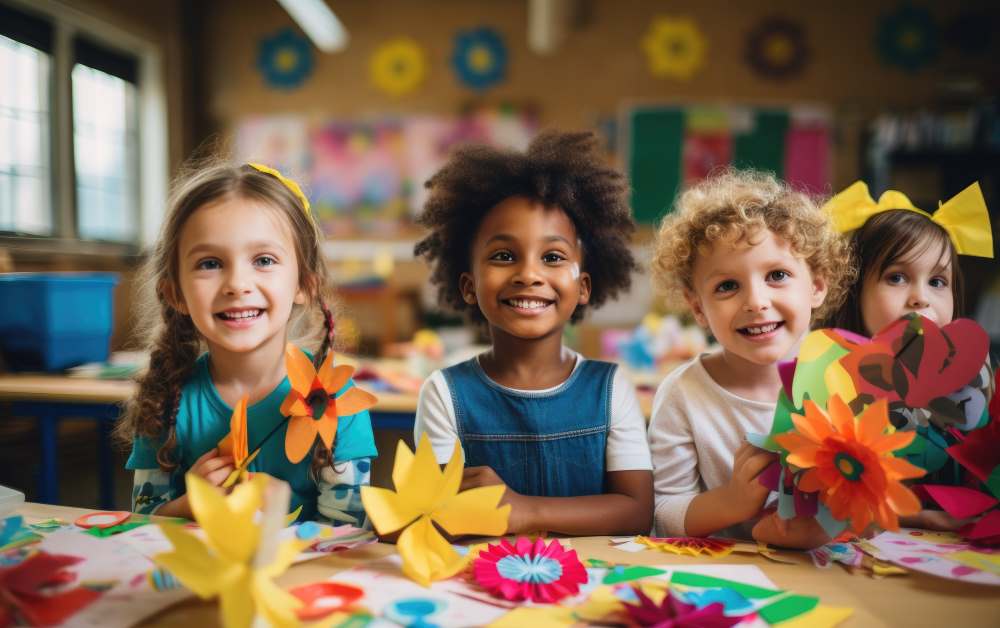
Creative play through art and craft activities significantly contributes to your child’s holistic development. These activities enhance their fine motor skills, fostering hand-eye coordination and small muscle control. Cognitive benefits include critical thinking and decision-making as children plan and execute projects.
Creative play also serves as an emotional outlet, stimulating imagination and aiding those with communication challenges. Language development occurs through communication with peers, and social skills are honed in group projects, promoting collaboration and problem-solving. The completion of art projects boosts self-esteem and confidence, fostering a positive self-image. Sensory exploration is promoted through engaging multiple senses, which a kids learning Brookvale center genuinely understands.
In this article, you’ll learn some examples of creative play activities involving arts and crafts and how they can help boost your child’s development.
-
Try making your Do-it-yourself (DIY) Storybook
Children’s interest in storybooks is multifaceted, encompassing cognitive, emotional, and social aspects of their development. Reading regularly with children not only supports their educational growth but also fosters a love for learning and storytelling.
So, why not encourage your children to write and illustrate their own stories? This activity can boost their literacy, creativity, and fine motor skills. Let them create characters, design the layout, and craft a cover for a comprehensive and enjoyable learning experience.
-
Explore Nature Collage
Take your children on a nature walk and have them collect various natural materials like leaves, sticks, and flowers.
Enhance your nature walk and exploration with various tools. Binoculars are great for observing birds and distant objects, while a magnifying glass provides a closer look at small insects and plants. Use a field guide to identify local wildlife and encourage recording observations in a notebook with a pencil.
Consider a bug catcher or critter jar for temporary holds on small creatures, and bring a dedicated nature journal for thoughts and experiences. Depending on your location, a map or compass can aid navigation.
Once you’re back home, engage them in creating a collage using these elements. This not only promotes an appreciation for nature but also enhances their artistic skills.
-
Build A Cardboard City
Collect cardboard boxes of different sizes and let your children transform them into a miniature city. This activity stimulates creativity, spatial awareness, and collaboration if done in a group. Have your children design buildings and streets, and even add a green park to their cardboard city.
Consider making a colorful skyline with basic building shapes, and let the children paint and decorate them with vibrant colors. Build 3D buildings using easily stackable and lightweight cardboard boxes, making sure they are safe for little hands to handle.
Design a city grid with roads and intersections, perhaps using markers or colored tape for simplicity. Introduce fun elements like cardboard cars, people, and animals to populate the city and spark imaginative storytelling.
Include easy-to-assemble landmarks that appeal to children’s curiosity, such as a cardboard castle, a friendly cardboard monster, or a rainbow bridge. Create green spaces with cardboard trees and maybe a cardboard pond for added fun.
To enhance the experience, you can add simple interactive elements like doors that open and close or flaps that reveal surprises. Use bright and contrasting colors to make the city visually engaging for young eyes.
Consider incorporating themes from their favorite stories or characters into the cardboard city to make it even more exciting. And, of course, keep safety in mind by using child-friendly materials and ensuring that any small parts are securely attached.
-
Make A Handprint Menagerie
In this activity, your child crafts a zoo or farm using their handprints as the basis for various animals. This hands-on project not only enhances their fine motor skills but also allows for artistic expression. Let your child choose an animal, and watch as they decorate it with colors and accessories, fostering individuality and creativity.
Beyond the artistic benefits, the activity provides valuable learning opportunities. Your child gains knowledge about different animals, their characteristics, and their habitats, making the educational experience engaging and memorable. The collaborative nature of the project encourages social interaction and communication skills as your child shares their knowledge and ideas.
The resulting handprint menagerie becomes a tangible representation of your child’s creativity. It serves as both a visual learning tool and a source of pride for them. This activity seamlessly integrates art, motor skill development, and education, making it a well-rounded and enriching experience.
Conclusion
Parents can boost their children’s creativity with arts and crafts. You can introduce different related activities and invest in arts and crafts supplies for a more enjoyable learning experience. Enrolling your child in a reputable kid learning center is also a great way to hone your child’s creative skills.



























